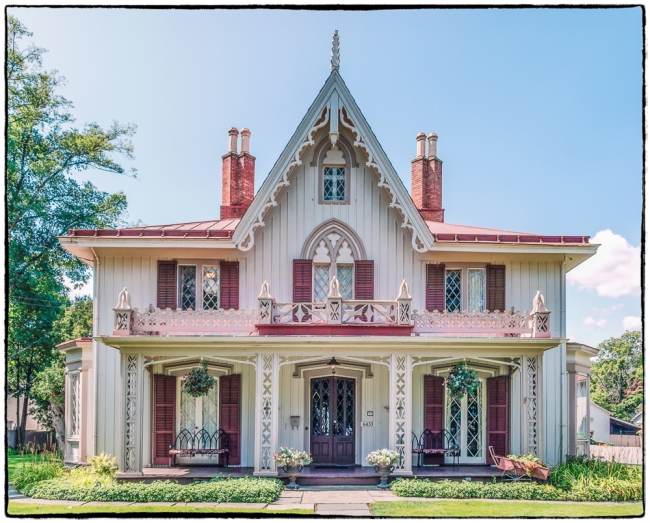According to the Poughkeepsie Journal (In “Dateline: Delamater Inn the ultimate American Gothic cottage“):
Located at 44 Montgomery St. (Route 9) in the Village of Rhinebeck, the Delamater Inn provides lodging in its namesake historic home, as well as in seven guest houses that occupy its property. The main house was built in 1844 as the home of Henry Delamater, founding president of the First National Bank of Rhinebeck.
The Gothic Revival-style house was designed by renowned architect Alexander Jackson Davis. It features a three-bay by two-bay configuration that is distinctive with its hip-roof block, which is bisected by a prominent steeply sloped pointed gable.
The front (east) side of the house features an ornamental veranda that boasts elegant carvings on each of its flat posts and on the parapet, which outlines the veranda roof. The two windows that flank the front door of the house include casement sashes, which open down to the floor.
Crafted with a unique design, the casements allow for one half of the window to open outward while the other half opens inward. When it was completed, the house was considered to be the “supreme example of the American Gothic cottage.”
The house was built on two acres on the west side of the village’s main thoroughfare, just north of its primary intersection. It served to physically separate the village’s commercial district from the more residential area to its immediate north.
In addition to founding and overseeing the Rhinebeck bank, Delamater was also the president of the village board and in 1846 was the Democratic Party’s candidate for Congress. He was viewed throughout his lifetime as one of Rhinebeck most influential and entrepreneurial figures and one that held significant influence in village matters.
Following Delamater’s death, the property was acquired by Raymond Rikert, who in 1900 founded the Dutchess Light, Heat and Power Company in the area of Rhinebeck known as Hog’s Bridge (today occupied by Northern Dutchess Hospital). The company was acquired by Central Hudson Gas & Electric Corp. in 1926.
The house was later owned by Gen. Ross Delafield, whose primary residence was Montgomery Place, the country estate established by Janet Livingston in 1802 and originally named Chateau de Montgomery in honor of her late husband Gen. Richard Montgomery. Montgomery was the first Continental Army officer killed in battle in 1775.
Coincidentally, Alexander Jackson Davis was also the architect of the manor house that Livingston erected on her estate.
In 1973, during Maj. John Delafield’s ownership, the Delamater House was placed on the National Register of Historic Places. Just five years earlier, the New York Chapter of the Society of Architectural Historians named the house “incomparably the best American Gothic cottage anywhere in the country.”
In 1979, Charles LaForge, then owner of the Beekman Arms, America’s oldest continuously operating inn, and his partner Timothy Toronto purchased the Delamater House for $90,000.
“We originally bought the house to fix up and flip it but during the late 1970s and early 1980s country inns were starting to become real popular so we decided to keep it and run it as an inn,” Toronto said.
The historic structure underwent an extensive renovation that included the installation of seven bathrooms, a revamping of the heating and plumbing and the repainting of the house’s exterior. The house was refashioned to feature eight bedrooms and over time other lodging buildings were added to the property.
The former Germond family house, which stood next to the bank across the street and was slated for demolition, was subsequently acquired by the partners. After relocating it to the Delamater property, it was reconfigured for additional lodging.
“We’d already converted the Delamater carriage house to four suites and added other buildings through the years to increase accommodations,” LaForge said. “Having the Delamater property opened more opportunities for us to accommodate groups and small conferences.”
LaForge has the distinction of being the longest owner of the landmark Beekman Arms, from 1958 through his retirement in 2002.
Taken with a Sony RX-100 M.

